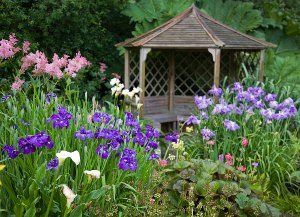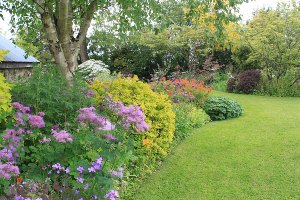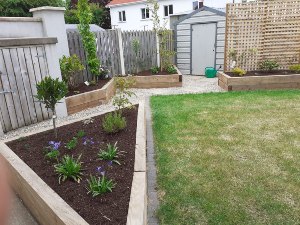Garden Design: A Q&A with Frances MacDonald
House
2
min read
08 Jul 2020

House2Home: The Complete Guide to Renovating or Redecorating
As restrictions lift, builders dust off hardhats and homeowners don paint rollers, decking tiles, grout filler and garden spades - hoping to rejuvenate spaces they’ve spent months staring at– we continue with our House2Home series, where we share expert advice around home renovation and redesign.
We sat down with well known garden designer, columnist and previous Bloom judge Frances MacDonald, who answered our questions on the ins and outs of redesigning a garden.
1. When embarking on a garden redesign, what kind of questions would you ask a client before starting?
All of the below factors determine the type of garden that we design and will have a bearing on what we have in our garden. Today with smaller gardens and most people working outside the home, the main brief is generally low maintenance but what clients usually mean is no maintenance!
Why do you want a garden?
- To look at from the house
- To enhance your home and increase the value
- To use for relaxation
- As a children's play area
- To experiment with plants
- To grow vegetables
2. Can you describe your own garden and what you like about it?
Our own garden is open to the public and is a series of 'rooms' or different types of gardens as it has been developed over the past 30 years. Fortunately we have had the space to explore and experiment with different styles.
My favourite part of our garden moves with the seasons. Ideally if I had a small garden, I would like it to be based on a typical Japanese design.
3. What are the main things people should think about if they want to redesign their garden?
Decide what you want /need in your garden?
- Lawn: this mean a lawnmower and a garden shed to house it. The alternative is hard-landscaping or planting
- Patio: ensure that it is big enough if you want to have a barbeque tables and chairs on it for eating outside. People tend to put the patio directly outside a door or French window leading into the garden. Observe first when the sunniest spot is - unless you choose to sit in the shade. If you have sufficient space, there is always an option to have two sitting areas if you want to have both morning and evening sun.
- Utility Area: no matter how small your garden is, a shed or storage area is essential. Think carefully about the positioning - a common misconception it to place it in the corner at the end of the garden; this means one always sees it from the house. This also applies to an oil tank. A retractable washing line is preferable to one that people think they will move - they never do! Wheelie Bins require a spot that is easy accessible to house and easy to maneuver for collection; a spot in the front garden is usually best with a 'green roof' over them.
- Vegetable garden: raised beds in either small or large gardens are best using the no dig method. There are easier to maintain and better for crop rotation. They should be at least 15" high with good topsoil and good drainage in a sunny spot. Use one for permanent edibles e.g. rhubarb, asparagus or herbs.
- Defining the Perimeter: Town gardens do not always require a hedge, a wall or fence against which plants can be grown is preferable. Country gardens require hedges generally for shelter and protection against animals invading the garden.
- Beds and Borders: This is similar to furnishing a home, choice of shrubs and flowers is down to personal taste but must also suit the soil and position of the garden - whether its sunny or shady.
4. How long might a complete redesign take for an average size garden? (design and work)
- Design: It usually takes one to two hours with a client to determine what they want for their garden, to measure the area and take notes and photographs. Then another meeting with the client to explain the design and make any changes.
- Work: Depending on the size of the garden, the work can take from two weeks to two months.
5. What kind of styles might you see gracing Irish gardens?
Gardening has moved from the industrial type conifer and heather beds in the 1960's, to lawns and rose beds, then to a predominance of herbaceous perennials and grass 'prairie style' gardens.
Today most gardens are regarded as an extension of the house and used for eating and entertainment. Interest  in cooking and healthy, eating has led to a 'Grow your Own' movement particularly among the younger gardeners.
in cooking and healthy, eating has led to a 'Grow your Own' movement particularly among the younger gardeners.
Sustainability and Re-Wilding are the buzzwords, an awareness of the need for bees and less dependency on chemicals to control nature. This is heaven for the lazy gardener who feels they can let their gardens fill with weeds and call it a 'natural landscape'!
6. For a client on a small budget, what small things might you suggest they do to improve their garden?
Interestingly plants are the cheapest part of any garden. Designed gardens have become more expensive because of the amount of hard landscaping and features required by clients. They also tend towards instant gardens and mature trees - not always the best idea. However for those on a budget and with very little experience, most plants, including trees and lawns, can be grown from seeds or cuttings.
Although it is not socially acceptable now, most gardens in the past were developed by people acquiring (stealing!) 'slips' or cuttings from gardens they visited! Start by sowing some hardy annuals in April - like Cosmos, Cornflowers, Sweetpeas etc. and you will have a colourful garden by the summer. Join a local garden club where tips and plants are shared by more experienced members. Watch gardening programmes on TV and follow garden blogs.
7. In terms of a small garden, would you have advice on how to make the most of a space like that?
the most of a space like that?
Making the most of your garden is like making the most of a room in your house - some people will go for minimalism and confine themselves to a lawn and one border while others will try to cram everything in...visit other gardens - there are over 400 public and private gardens open in Ireland during the summer months.
Its a great way of seeing what you would like and if it would translate to your own space. Most gardeners are more than delighted to share their knowledge.
8. What is the average cost you would see in terms of design and creation of an average size garden?
Cost of design depends not always on the size of the garden but on the amount of detail in it. The last suburban garden that we designed and then landscaped with lawn, raised beds and borders, patios etc. cost about €10,500 including design.
An interest in gardening has made a resurgence during the lockdown as people have been confined to their homes. They have had more attention also because of the long spell of good weather. People also became aware of the importance of their own open space. Whether this interest will be maintained is hard to tell.
The Bay Garden, south of Camolin, Enniscorthy, Co. Wexford is owned by Frances and Iain MacDonald. It is now open for appointment bookings for small groups, by calling 086-843 6624 or emailing thebaygarden@gmail.com. You can also view their garden online also.
Frances MacDonald has worked in gardening for over 35 years. She trained in the National Botanic Gardens in Dublin, and runs a renowned garden and landscaping business in Wexford called the Bay Garden. She has worked as the series consultant on the RTE Radio 1 programme ‘Planting Passions’ and she and Iain have featured in the ‘Garden Heaven’ programme on RTE television. She has also been a judge for the Garden Heaven Show, the All Ireland National Garden Competition, Harrogate Flower Show, Hillsborough Show and has previously judged at Bloom. She has a monthly column in The Irish Garden magazine. Frances is Garden Tours Manager with the Travel Department and organises and guides tours at home and abroad.
You can keep an eye out for more great content on #House2Home across Facebook, Twitter, or Instagram. If you need any help with budgeting or financial support with your project, (big or small) don’t hesitate to contact your local credit union - we’re here to help.